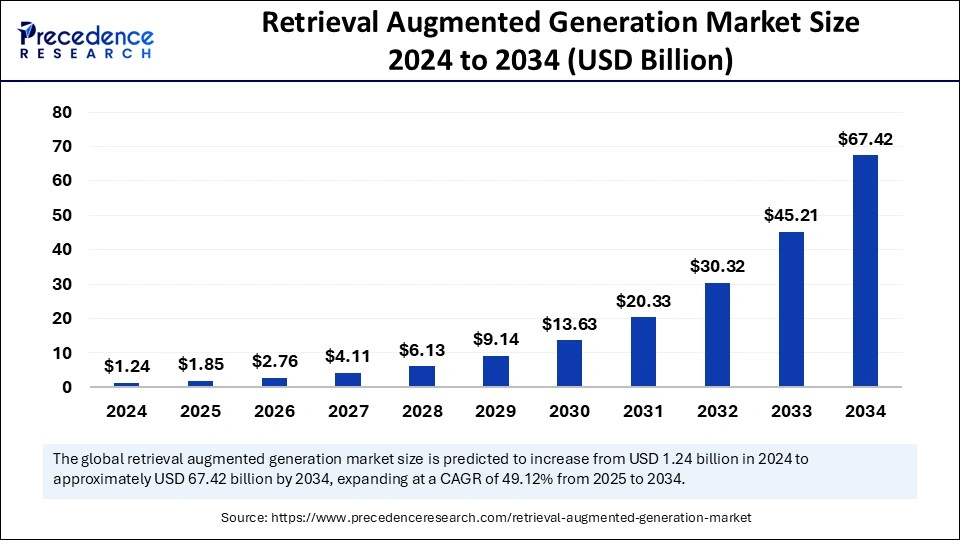
Retrieval Augmented Generation Market Key Takeaways
- North America dominated the global market with the largest share around 37% in 2024.
- Asia Pacific is expected to grow at the fastest CAGR during the forecast period.
- The European market is observed to grow at a considerable CAGR.
- By function, the document retrieval segment dominated the market in 2024.
- By function, the recommendation engine segment is expected to witness significant growth during the predicted timeframe.
- By application, in 2024, the content-generation segment captured the biggest market share in 2024.
- By application, the customer support and chatbots segment is expected to grow at the fastest CAGR over the forecast period.
- By end use, the retail and e-commerce segment contributed the highest market share in 2024.
- By end use, the healthcare segment is expected to grow at the fastest CAGR in the studied years.
- By deployment, the cloud segment held the largest market share in 2024.
- By deployment, the on-premises segment is expected to grow at the fastest CAGR in the coming years.
Market Overview
The retrieval augmented generation market is emerging as a pivotal segment within the broader artificial intelligence and natural language processing landscape. Retrieval augmented generation (RAG) combines the capabilities of large language models with external information retrieval systems to produce more accurate and contextually grounded responses. This hybrid AI architecture is increasingly being adopted by enterprises to enhance customer service automation, content creation, search engines, and enterprise knowledge management systems.
As industries seek more explainable and data-backed generative models, the retrieval augmented generation market is witnessing accelerated growth and attracting substantial investments.
Drivers
The rapid adoption of generative AI solutions across multiple industries is a major driver fueling the retrieval augmented generation market. Unlike traditional generative models, RAG systems can access external databases and documents during response generation, resulting in higher accuracy and reliability. Organizations, particularly in sectors such as healthcare, legal, finance, and research, are leveraging RAG for better decision-making and regulatory compliance.
Additionally, the growing emphasis on reducing hallucinations in generative AI outputs is prompting companies to shift toward retrieval-based models, thereby driving the growth of the retrieval augmented generation market.
Opportunities
The retrieval augmented generation market offers substantial opportunities in areas where real-time, contextually accurate information retrieval is critical. Industries focused on customer engagement, legal documentation, academic research, and corporate training are likely to invest heavily in RAG solutions.
The market also presents growth potential in the development of multilingual and domain-specific RAG systems. As small and medium-sized enterprises adopt AI-driven tools to optimize their workflows, scalable and cost-effective RAG platforms will find increased demand. Moreover, integration with cloud infrastructure and API-based deployment models offer vendors an opportunity to serve global clients with minimal barriers.
Challenges
Despite its potential, the retrieval augmented generation market faces several challenges. The complexity of integrating RAG models with diverse and unstructured databases often demands significant technical expertise and infrastructure. Ensuring data privacy and managing secure access to proprietary or sensitive information also complicate RAG deployments.
Another hurdle is maintaining low-latency performance, especially when dealing with large-scale retrieval tasks. Furthermore, standardization is still lacking, and the absence of unified benchmarks can hinder product validation and client trust, slowing the adoption rate of retrieval augmented generation solutions.
Regional Insights
North America currently dominates the retrieval augmented generation market due to the strong presence of AI-focused startups, major cloud providers, and leading research institutions. The United States is spearheading innovation in RAG technologies, supported by high AI adoption rates in sectors such as healthcare, defense, and e-commerce.
Europe is also a growing market, particularly in countries like Germany, France, and the UK, where data-driven governance and research initiatives are prominent. Meanwhile, the Asia-Pacific region is showing increasing interest, with China, South Korea, and India investing in generative AI applications, creating new avenues for the retrieval augmented generation market to expand.
Recent Developments
Recent developments in the retrieval augmented generation market include the introduction of hybrid cloud-native RAG platforms by leading tech firms. Enterprises are focusing on enhancing the retrieval accuracy and real-time adaptability of their AI systems. Notable advancements also include RAG-powered assistants tailored for scientific research, legal case management, and real-time business analytics.
Strategic partnerships between AI software providers and cloud service platforms have further improved scalability and performance. Additionally, open-source RAG frameworks are gaining traction, enabling faster innovation cycles and adoption across a wider range of business use cases.
Retrieval Augmented Generation Market Companies
- Anthropic
- Amazon Web Services Inc.
- Clarifai
- Cohere
- Google DeepMind
- Hugging Face
- IBM Watson
- Informatica
- Meta AI (Facebook AI)
- Microsoft
- Neeva
- OpenAI
- Semantic Scholar (AI2)
Segments Covered in Report
By Function
- Document Retrieval
- Response Generation
- Summarization and Reporting
- Recommendation Engines
By Application
- Knowledge Management
- Customer Support and Chatbots
- Legal and Compliance
- Marketing and Sales
- Research and Development
- Content Generation
By End User
- Healthcare
- Financial Services
- Retail and E-commerce
- IT and Telecommunications
- Education
- Media and Entertainment
- Others
By Deployment
- Cloud
- On-premises
By Regional
- North America
- Europe
- Asia Pacific
- Latin America
- Middle East and Africa
